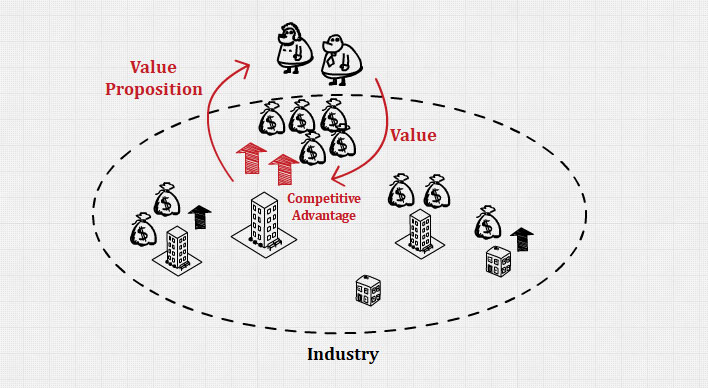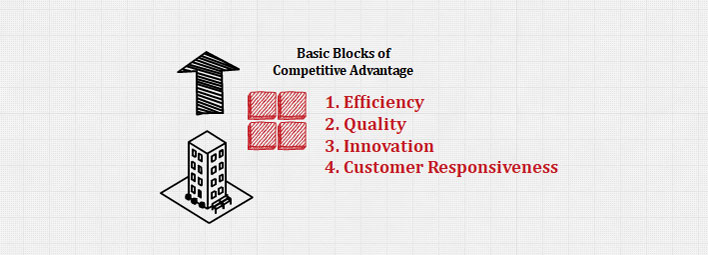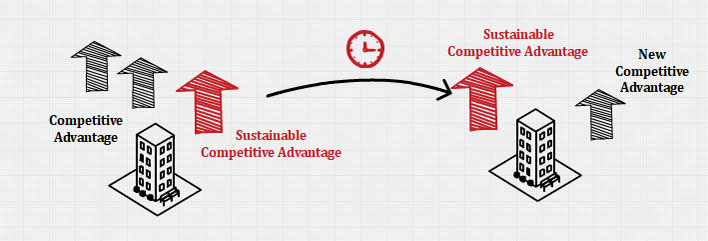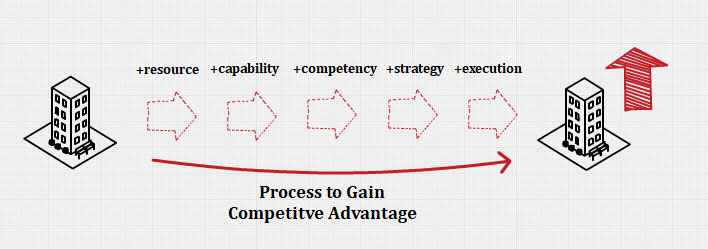Competitive Advantage & Creating Value

A company has a competitive advantage when its profitability is higher than the average for its industry.
A company with a competitive advantage will have superior profitability. This sends a signal to rivals that the company has some valuable distinctive competency that allows it to create superior value.
A company’s profitability is determined by 2 conditions: (1) the costs of production, and (2) the value amount customers place on the goods or services.
Firms with a competitive advantage create more value for customers than do competitors. The stronger these firms’ distinctive competencies, the greater the amount of potential value they’re able to create for their customers.
Value is measured by performance characteristics of the product and/or service, and by its attributes for which customers are willing to pay.
The price of goods or services is usually less than the value amount placed on the product by many customers.
The first reason is that the price a company charges for a good or service is typically less than the value placed on that good or service by the average customer. This is because the average customer captures some of that value in the form of a consumer surplus. Note that in general, the more value customers place on a company’s products, the higher the price the company can charge for those products.
The second reason is that the company is competing with other companies, so they must charge lower prices than they could were they a monopoly supplier.
The third reason is that it is normally impossible to segment the market to such a degree that the company can charge each customer a price that reflects that individual’s assessment of the value of a product.
A company has high profitability, and thus a competitive advantage, when it creates more value for its customers than rivals do. The concept of value creation lies at the heart of competitive advantage.
In general, low cost and differentiation are 2 generic strategies for creating value and attaining a competitive advantage in an industry. Competitive advantage, and thus higher profitability, goes to those companies that can create superior value.
The way to create superior value is to drive down the cost structure of the business, and/or differentiate the product in some way so that customers and consumers value it more and are willing to pay a premium price or a combination of both.
However, superior value creation does not necessarily require a company to have the lowest cost structure in an industry or to create the most valuable product in the eyes of consumers. What it requires is the gap between perceived value and costs of production be greater than the gap attained by competitors.
Ultimately, creating value for customers is the source of above-average returns for a firm. What the firm intends regarding value creation affects its choice of business-level strategy.
A business-level strategy is effective only when it is grounded in exploiting the firm’s resources, capabilities, and competencies. Thus, a successful firm should continuously examine the effectiveness of current resources, capabilities, and competencies while thinking about the future resources, capabilities, and competencies it will require for future success.
Historically, firms’ efforts to create value were largely oriented toward understanding the characteristics of their industry in which they competed and, in light of those characteristics, determining how they should be positioned relative to competitors.
This emphasis on industry characteristics and competitive strategy underestimated the role of the firm’s resources and capabilities in developing core competencies as the source of competitive advantages.
In fact, competencies are the firm’s most important sources of competitive advantage. A firm’s core competencies, integrated with an understanding of the results of studying the conditions in the external environment, should drive the selection of strategies.
By emphasizing core competencies when selecting and implementing strategies, companies learn to compete primarily based on firm-specific differences. However, while doing so they must be simultaneously aware of changes in the firm’s external environment.
How exactly can a company drive down its cost structure and differentiate its product offering from that of competitors so that it can create superior value?
If a firm has weak capabilities or does not have core competencies in areas required to achieve a competitive advantage, it must acquire those resources and build the needed capabilities and competencies.
Alternatively, the firm could decide to outsource a function or activity where it is weak in order to improve its ability to use its remaining resources to create a competitive advantage. Tools such as outsourcing help the firm focus on its core competencies as the source of its competitive advantages.
Note that the ability of core competence to be a sustainable competitive advantage and thus to create value can’t be assumed. The reason for these cautions is that all core competencies have the potential to become core rigidities.
Building Blocks of Competitive Advantage

Competitive advantage has 4 building blocks: (1) efficiency, (2) quality, (3) innovation, and (4) customer responsiveness.
When a company is uniquely skilled at a value chain activity that underlies superior efficiency, quality, innovation, or customer responsiveness relative to its rivals, we say that it has a distinctive competency in this activity.
They are the generic building blocks of competitive advantage that any company can adopt, regardless of its industry or the products or services it produces.
These factors are interrelated. For example, superior quality can lead to superior efficiency, while innovation can enhance efficiency, quality, and customer responsiveness.
For a company to outperform its rivals, it must have distinctive competencies, in at least one of these building blocks. Thus, this company can do so because they are generally more efficient, have higher product quality, are more innovative, or are more responsive to their customer than are their rivals.
If firms are successful in their efforts to improve efficiency, quality, innovation, and customer responsiveness, they may lower the cost structure and/or better differentiate their product offering, either of which can be the basis for a competitive advantage.
Competitive Advantage Sustainability

A company has a sustained competitive advantage when it is able to maintain superior profitability over a number of years.
Being able to develop a competitive advantage using its resources, capabilities, and competencies does not mean that the organization can sustain it.
A sustainable competitive advantage exists only when competitors are unable to duplicate the benefits of a firm’s strategy or when they lack the resources to attempt imitation.
Even if the firm develops and manages resources and capabilities in ways that create core competencies and competitive advantages, competitors will eventually learn how to duplicate the benefits of any firm’s value-creating strategy.
Thus, all competitive advantages have a limited life.
For all firms, the challenge is to effectively manage current core competencies while
simultaneously developing new ones. Only when firms are able to do this can they expect to achieve strategic competitiveness, earn above-average returns, and remain ahead of competitors in both the short and long term.
In general, a competitive advantage’s sustainability is a function of 3 factors: (1) the durability of internal strategic factors; (2) the availability of substitutes for the core competence; and (3) the imitability of the core competence.
Durability of Internal Strategic Factors
This is the rate at which the organization’s underlying resources, capabilities, and competencies mature, depreciate, and become obsolete either because of itself or because of changes in the external environment.
Availability of Substitutes
Competitors may invent their way around the source of competitive advantage. Even if a company’s distinctive competencies are protected, rivals can try to nullify the source of competitive advantage by developing new ways of doing business, that are substitutes to which the firm is doing.
Imitability of Core Competencies
This is the rate at which the organization’s underlying resources, capabilities, and competencies can be duplicated by competitors.
To the extent that a distinctive competency gives a competitive advantage to the organization, competitors will try what they can to learn and imitate that set of resources, capabilities, and competencies. Insofar as they are successful, ultimately the imitators may compete away from the company’s superior profitability. The speed at which this process occurs depends upon the height of barriers to imitation.
Barriers to imitation are factors that make it difficult for a competitor to copy a company’s distinctive competencies.
The greater the barriers to imitation, the more sustainable are a company’s competitive advantage.
A core competency can be imitated easily or not depending on whether it is based on tangible resources, intangible resources, or capabilities.
Thus, barriers to imitation differ depending on whether a competitor is trying to imitate resources or capabilities.
In general, firm-specific and valuable tangible resources make up the easiest distinctive competencies for prospective rivals to imitate. These resources are buildings, plants, or equipment, and so on. Such resources are visible to competitors and can often be purchased on the open market.
Intangible resources can be more difficult to imitate. This is particularly true of brand names, which are important because they symbolize a company’s reputation. Although competitors might like to imitate well-established brand names, the law prohibits them from doing so.
Other important intangible resources are marketing and technology know-how, which can be relatively easy to imitate as well. Successful marketing strategies are relatively easy to imitate because they are so visible to competitors.
With regard to technological know-how, the patent system, in theory, should make technological know-how relatively immune to imitation. However, it is often possible to invent around patents, which means to produce a product that is functionally equivalent but does not rely upon the patented technology. In general, distinctive competencies based on technological know-how can be relatively short-lived.
A company’s capabilities tend to be more difficult to imitate than its tangible and intangible resources, mainly because capabilities are based on the way in which decisions are made, processes are managed deep within a company. It is hard for competitors to discern them.
The invisible nature of capabilities would not be enough to halt imitation. Competitors could still gain insights into how a company operates by hiring people away from that company. However, a company’s capabilities rarely reside in a single individual. Rather, they are the product of how numerous individuals interact within a unique organizational setting.
It is possible that no one individual within a company may be familiar with the totality of a company’s internal operating routines and procedures. In such cases, hiring people away from a successful company in order to imitate its key capabilities may not be helpful.
In sum, a company’s competitive advantage tends to be more secure when it is based upon intangible resources and capabilities, as opposed to tangible resources. Capabilities can be particularly difficult to imitate since doing so requires the competitors to change their own internal organizational setting.
A core competency can be easily imitated if it is transparent, transferable, and replicable.
Transparency is the speed at which other firms can understand the relationship between resources and capabilities.
Transferability is the ability of competitors to gather the resources and capabilities necessary to imitate competition.
Replicability is the ability of competitors to use duplicated resources and capabilities to imitate completion.
A core competency can also be imitated depending on whether it is built based on explicit knowledge, instead of tacit knowledge.
Explicit knowledge is a type of knowledge that can be easily articulated and communicated. Competitive intelligence activities can quickly identify this type of knowledge.
Tacit knowledge is a type of knowledge that is not easily communicated because it is deeply rooted in employee experience or the organization’s culture.
Process to Gain Competitive Advantages

A resource-based approach to gaining competitive advantage consists of the following 5 steps.
Step 1: Identify and classify the resources of the organization in terms of internal strategic factors (strengths and weaknesses).
Step 2: Utilize capabilities to turn the identified resources and/or strategic resources into specific competencies, core competencies, and distinctive competencies.
Step 3: Appraise the potential profit of these competencies, core competencies, and distinctive competencies in terms of business-level strategy.
Step 4: Evaluate the business-level strategy that best exploits the internal strengths and weaknesses of the firm, in light of external opportunities and threats.
Step 5: Execute the selected business-level strategy to competitively position the firm in the industry, thus gain competitive
The desire to gain a competitive advantage by building or upgrading a core competency is one of the reasons why entrepreneurial and other startup firms often tend to locate close to their competitors, as to form a cluster.
A cluster provides access to employees, suppliers, and specialized information. Employees from different firms within a cluster often socialize and exchange ideas and skills. As a result, companies can learn from each other while compete with each other.
Resources
Further Reading
- Competitive Advantage (investopedia.com)
- What is Competitive Advantage (thebalance.com)
- Strategies to Define your Competitive Advantage (garfinkleexecutivecoaching.com)
- Competitive Advantage – Creating and Sustaining Superior Performance [Review] (culttt.com)
- Competitive Advantage (quickmba.com)
- From Competitive Advantage to Corporate Strategy (hbr.org)
- What is Value Chain Analysis? How to Deliver Value & Gain a Competitive Advantage (business2community.com)
- Competitive Advantage (oberlo.com)
- Competitive Advantage (thwink.org)
Even More Reading
Related Concepts
References
- Hitt, M. A., Ireland, D. R., & Hoskisson, R. E. (2019). Strategic Management: Concepts and Cases: Competitiveness and Globalization (MindTap Course List) (13th ed.). Cengage Learning.
- Hill, C. W. L., & Jones, G. R. (2011). Essentials of Strategic Management (Available Titles CourseMate) (3rd ed.). Cengage Learning.
- Mastering Strategic Management. (2016, January 18). Open Textbooks for Hong Kong. http://www.opentextbooks.org.hk/ditabook/17062
- Wheelen, T. L. (2021). Strategic Management and Business Policy: Toward Global Sustainability 13th (thirteenth) edition Text Only. Prentice Hall.